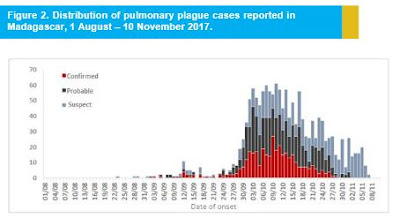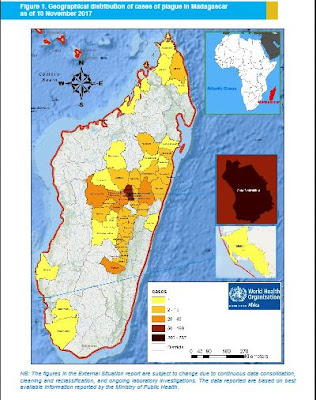#12,899
While you wouldn't guess it by the breathless coverage in the tabloids, the news out of Madagascar continues to be encouraging, although the WHO is quick to point out the crisis is far from over. Even in normal years plague cases on the island can be reported well into April, and this year has been anything but normal.
In this latest WHO Sitrep - with numbers updated through the 10th of November - a cumulative total of 2,119 confirmed, probable and suspected cases of plague, including 171 deaths (CFR of 8%), have been reported.
The number of new cases continues to slow (see epi curve above), leading to the following updated Risk Assessment.
The number of new cases of pneumonic plague has steadily declined since mid-October. From 7 to 10 November 2017, 73 pneumonic and 9 bubonic cases of plague have been reported to WHO. While the number of new cases and hospitalizations of patients due to plague is declining in Madagascar, WHO anticipates additional cases to be reported until the typical plague season ends in April 2018.
Based on available information and response measures implemented to date, the potential risk of further spread of plague at national level remains high. The risk of international spread is mitigated by the short incubation period of pneumonic plague, implementation of exit screening measures and advice to traveller to Madagascar, and scaling up of preparedness and operational readiness activities in neighbouring Indian Ocean islands and other southern and east African countries. The overall global risk is considered to be low.
WHO is re-evaluating the risk assessment based on the evolution of the outbreak and information from response activities.Some excepts from the latest Situation Update follow:
Date of issue: 14 November 2017
WHO continues to support the Ministry of Public Health and other national authorities in Madagascar to monitor and respond to the outbreak of plague. From 7 to 10 November 2017, 86 confirmed, probable and suspect cases of plague were reported.
From 1 August to 10 November 2017, a cumulative total of 2 119 confirmed, probable and suspected cases of plague, including 171 deaths (case fatality rate 8%), have been reported from 55 of 114 (48%) districts in Madagascar.
Analamanga Region has been the most affected, with 72% of all recorded cases.Since the beginning of the outbreak, 1 618 (76%) of reported cases have clinically been classified as pulmonary plague, 324 (15%) as bubonic plague, one was septicaemic, and 176 have not yet been classified (further classification of cases is in process). A total of 82 healthcare workers (with no deaths) have been affected.
Of the 1 618 clinical cases of pneumonic plague, 365 (23%) have been confirmed, 573 (35%) are probable and 680 (42%) remain suspected (additional laboratory results are in process). Twenty-five isolates of Yersinia pestis have been cultured and are sensitive to all antibiotics recommended by the National Plague Control Program.
About 95% (6 729) of 7 122 contacts identified thus far have completed their 7-day follow up and a course of prophylactic antibiotics. Since the beginning of the outbreak, a total of eleven contacts developed symptoms and became suspected cases. On 10 November 2017, 218 out of 243 (90%) contacts under follow-up were reached and provided with prophylactic antibiotics.
Plague is endemic on the Plateaux of Madagascar, including Ankazobe District, where the current outbreak originated. A seasonal upsurge, predominantly of the bubonic form, usually occurs yearly between September and April. This year, the plague season began earlier and the current outbreak is predominantly pneumonic and is affecting both endemic and non-endemic areas, including major urban centres such as Antananarivo (the capital city) and
Toamasina (the port city).
There are three forms of plague, depending on the route of infection: bubonic, septicaemic and pneumonic (for more information, see the link http://www.who.int/mediacentre/factsheets/fs267/en/).


